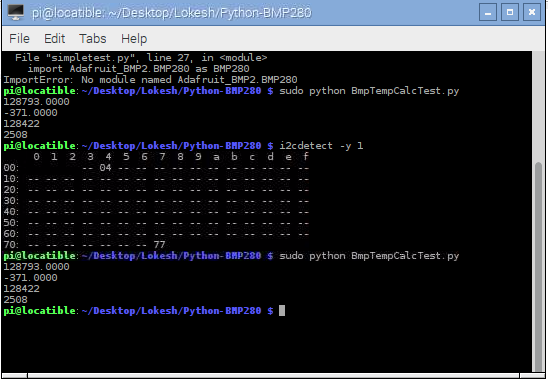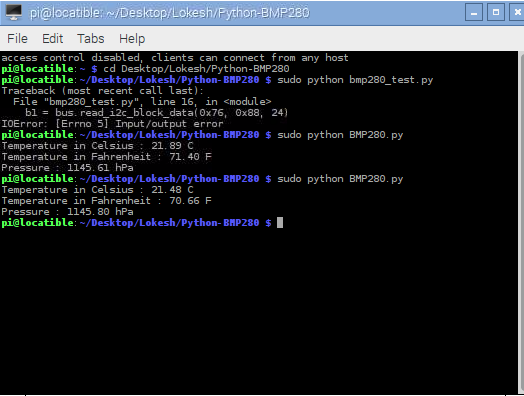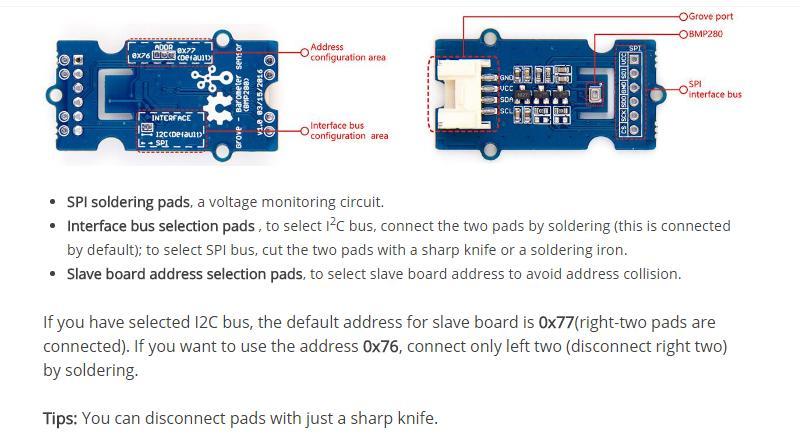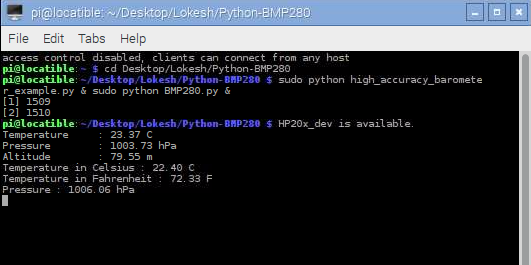Hi @Shoban,
Please note I am using BMP280, not BME280.
I did the following,
-
I checked i2cdetect -y 1 command using both the sensors separately. And every time they detect default address 0x77.
-
I ran the code you sent to me earlier. Both the sensors work well for 0x77 address.
-
Then I changed the code for 0x76 address and here is the code I am using at the moment,
Distributed with a free-will license.
Use it any way you want, profit or free, provided it fits in the licenses of its associated works.
BMP280
This code is designed to work with the BMP280_I2CS I2C Mini Module available from ControlEverything.com.
import smbus
import time
Get I2C bus
bus = smbus.SMBus(1)
BMP280 address, 0x76(118)
Read data back from 0x88(136), 24 bytes
b1 = bus.read_i2c_block_data(0x76, 0x88, 24)
Convert the data
Temp coefficents
dig_T1 = b1[1] * 256 + b1[0]
dig_T2 = b1[3] * 256 + b1[2]
if dig_T2 > 32767 :
dig_T2 -= 65536
dig_T3 = b1[5] * 256 + b1[4]
if dig_T3 > 32767 :
dig_T3 -= 65536
Pressure coefficents
dig_P1 = b1[7] * 256 + b1[6]
dig_P2 = b1[9] * 256 + b1[8]
if dig_P2 > 32767 :
dig_P2 -= 65536
dig_P3 = b1[11] * 256 + b1[10]
if dig_P3 > 32767 :
dig_P3 -= 65536
dig_P4 = b1[13] * 256 + b1[12]
if dig_P4 > 32767 :
dig_P4 -= 65536
dig_P5 = b1[15] * 256 + b1[14]
if dig_P5 > 32767 :
dig_P5 -= 65536
dig_P6 = b1[17] * 256 + b1[16]
if dig_P6 > 32767 :
dig_P6 -= 65536
dig_P7 = b1[19] * 256 + b1[18]
if dig_P7 > 32767 :
dig_P7 -= 65536
dig_P8 = b1[21] * 256 + b1[20]
if dig_P8 > 32767 :
dig_P8 -= 65536
dig_P9 = b1[23] * 256 + b1[22]
if dig_P9 > 32767 :
dig_P9 -= 65536
BMP280 address, 0x76(118)
Select Control measurement register, 0xF4(244)
0x27(39) Pressure and Temperature Oversampling rate = 1
Normal mode
bus.write_byte_data(0x76, 0xF4, 0x27)
BMP280 address, 0x76(118)
Select Configuration register, 0xF5(245)
0xA0(00) Stand_by time = 1000 ms
bus.write_byte_data(0x76, 0xF5, 0xA0)
time.sleep(0.5)
BMP280 address, 0x76(118)
Read data back from 0xF7(247), 8 bytes
Pressure MSB, Pressure LSB, Pressure xLSB, Temperature MSB, Temperature LSB
Temperature xLSB, Humidity MSB, Humidity LSB
data = bus.read_i2c_block_data(0x76, 0xF7, 8)
Convert pressure and temperature data to 19-bits
adc_p = ((data[0] * 65536) + (data[1] * 256) + (data[2] & 0xF0)) / 16
adc_t = ((data[3] * 65536) + (data[4] * 256) + (data[5] & 0xF0)) / 16
Temperature offset calculations
var1 = ((adc_t) / 16384.0 - (dig_T1) / 1024.0) * (dig_T2)
var2 = (((adc_t) / 131072.0 - (dig_T1) / 8192.0) * ((adc_t)/131072.0 - (dig_T1)/8192.0)) * (dig_T3)
t_fine = (var1 + var2)
cTemp = (var1 + var2) / 5120.0
fTemp = cTemp * 1.8 + 32
Pressure offset calculations
var1 = (t_fine / 2.0) - 64000.0
var2 = var1 * var1 * (dig_P6) / 32768.0
var2 = var2 + var1 * (dig_P5) * 2.0
var2 = (var2 / 4.0) + ((dig_P4) * 65536.0)
var1 = ((dig_P3) * var1 * var1 / 524288.0 + ( dig_P2) * var1) / 524288.0
var1 = (1.0 + var1 / 32768.0) * (dig_P1)
p = 1048576.0 - adc_p
p = (p - (var2 / 4096.0)) * 6250.0 / var1
var1 = (dig_P9) * p * p / 2147483648.0
var2 = p * (dig_P8) / 32768.0
pressure = (p + (var1 + var2 + (dig_P7)) / 16.0) / 100
Output data to screen
print “Temperature in Celsius : %.2f C” %cTemp
print “Temperature in Fahrenheit : %.2f F” %fTemp
print "Pressure : %.2f hPa " %pressure
And this is the code for 0x77 address (it is working fine)
Distributed with a free-will license.
Use it any way you want, profit or free, provided it fits in the licenses of its associated works.
BMP280
This code is designed to work with the BMP280_I2CS I2C Mini Module available from ControlEverything.com.
import smbus
import time
Get I2C bus
bus = smbus.SMBus(1)
BMP280 address, 0x77(118)
Read data back from 0x88(136), 24 bytes
b1 = bus.read_i2c_block_data(0x77, 0x88, 24)
Convert the data
Temp coefficents
dig_T1 = b1[1] * 256 + b1[0]
dig_T2 = b1[3] * 256 + b1[2]
if dig_T2 > 32767 :
dig_T2 -= 65536
dig_T3 = b1[5] * 256 + b1[4]
if dig_T3 > 32767 :
dig_T3 -= 65536
Pressure coefficents
dig_P1 = b1[7] * 256 + b1[6]
dig_P2 = b1[9] * 256 + b1[8]
if dig_P2 > 32767 :
dig_P2 -= 65536
dig_P3 = b1[11] * 256 + b1[10]
if dig_P3 > 32767 :
dig_P3 -= 65536
dig_P4 = b1[13] * 256 + b1[12]
if dig_P4 > 32767 :
dig_P4 -= 65536
dig_P5 = b1[15] * 256 + b1[14]
if dig_P5 > 32767 :
dig_P5 -= 65536
dig_P6 = b1[17] * 256 + b1[16]
if dig_P6 > 32767 :
dig_P6 -= 65536
dig_P7 = b1[19] * 256 + b1[18]
if dig_P7 > 32767 :
dig_P7 -= 65536
dig_P8 = b1[21] * 256 + b1[20]
if dig_P8 > 32767 :
dig_P8 -= 65536
dig_P9 = b1[23] * 256 + b1[22]
if dig_P9 > 32767 :
dig_P9 -= 65536
BMP280 address, 0x77(118)
Select Control measurement register, 0xF4(244)
0x27(39) Pressure and Temperature Oversampling rate = 1
Normal mode
bus.write_byte_data(0x77, 0xF4, 0x27)
BMP280 address, 0x77(118)
Select Configuration register, 0xF5(245)
0xA0(00) Stand_by time = 1000 ms
bus.write_byte_data(0x77, 0xF5, 0xA0)
time.sleep(0.5)
BMP280 address, 0x77(118)
Read data back from 0xF7(247), 8 bytes
Pressure MSB, Pressure LSB, Pressure xLSB, Temperature MSB, Temperature LSB
Temperature xLSB, Humidity MSB, Humidity LSB
data = bus.read_i2c_block_data(0x77, 0xF7, 8)
Convert pressure and temperature data to 19-bits
adc_p = ((data[0] * 65536) + (data[1] * 256) + (data[2] & 0xF0)) / 16
adc_t = ((data[3] * 65536) + (data[4] * 256) + (data[5] & 0xF0)) / 16
Temperature offset calculations
var1 = ((adc_t) / 16384.0 - (dig_T1) / 1024.0) * (dig_T2)
var2 = (((adc_t) / 131072.0 - (dig_T1) / 8192.0) * ((adc_t)/131072.0 - (dig_T1)/8192.0)) * (dig_T3)
t_fine = (var1 + var2)
cTemp = (var1 + var2) / 5120.0
fTemp = cTemp * 1.8 + 32
Pressure offset calculations
var1 = (t_fine / 2.0) - 64000.0
var2 = var1 * var1 * (dig_P6) / 32768.0
var2 = var2 + var1 * (dig_P5) * 2.0
var2 = (var2 / 4.0) + ((dig_P4) * 65536.0)
var1 = ((dig_P3) * var1 * var1 / 524288.0 + ( dig_P2) * var1) / 524288.0
var1 = (1.0 + var1 / 32768.0) * (dig_P1)
p = 1048576.0 - adc_p
p = (p - (var2 / 4096.0)) * 6250.0 / var1
var1 = (dig_P9) * p * p / 2147483648.0
var2 = p * (dig_P8) / 32768.0
pressure = (p + (var1 + var2 + (dig_P7)) / 16.0) / 100
Output data to screen
print “Temperature in Celsius : %.2f C” %cTemp
print “Temperature in Fahrenheit : %.2f F” %fTemp
print "Pressure : %.2f hPa " %pressure
Both the codes are the same. The only difference is that I am using 0x76 address for the first code (which is not working) and 0x77 address for the second code (which is working.)
I am getting the error which is in the picture.
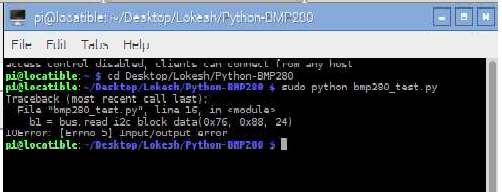
Here is the connection picture to the sensor when I am using the code for 0x76 address.
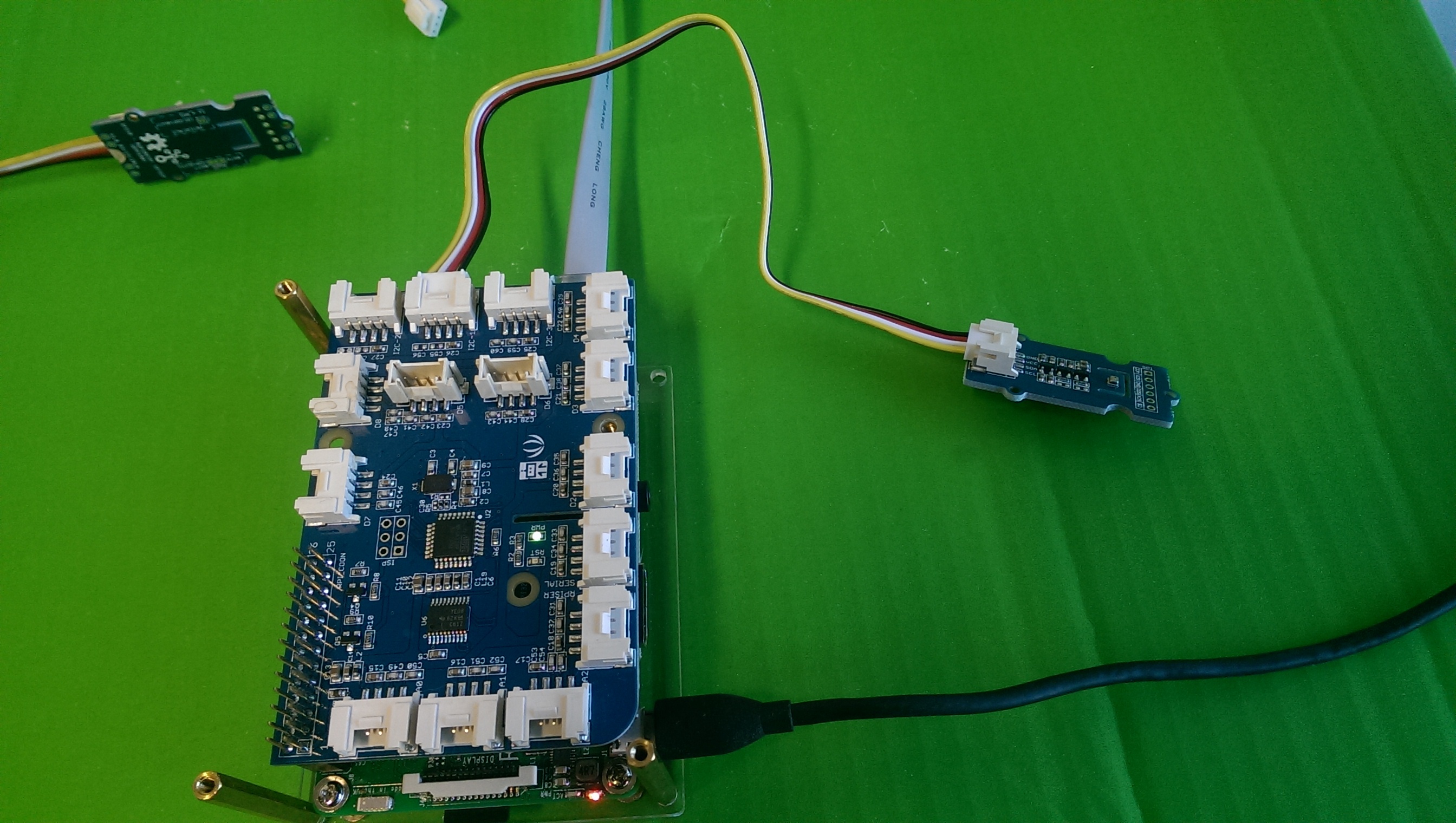
Is there anything wrong in the connection? In the previous post you said that, I have to change the address to 0x76 by adjusting the address selector on the sensor board. How can I do that? Can you please post a picture or something about it?
Thanks.
Lokesh
